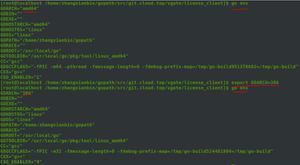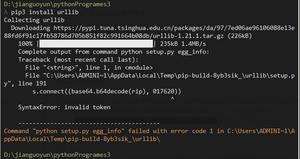在64位Linux和64位处理器上运行32位汇编代码:解释异常
我遇到了一个有趣的问题,我忘记了我正在使用64位计算机和操作系统,并编写了32位汇编代码。我不知道如何编写64位代码。
这是Linux上Gnu汇编程序(AT&T语法)的x86 32位汇编代码。
//hello.S#include <asm/unistd.h>
#include <syscall.h>
#define STDOUT 1
.data
hellostr:
.ascii "hello wolrd\n";
helloend:
.text
.globl _start
_start:
movl $(SYS_write) , %eax //ssize_t write(int fd, const void *buf, size_t count);
movl $(STDOUT) , %ebx
movl $hellostr , %ecx
movl $(helloend-hellostr) , %edx
int $0x80
movl $(SYS_exit), %eax //void _exit(int status);
xorl %ebx, %ebx
int $0x80
ret
现在,此代码应该可以在32位处理器和32位操作系统上正常运行,对吗?众所周知,64位处理器与32位处理器向后兼容。因此,这也不是问题。由于在64位OS和32位OS中系统调用和调用机制存在差异,因此出现了问题。我不知道为什么,但是他们在32位linux和64位linux之间更改了系统调用号。
asm / unistd_32.h定义:
#define __NR_write 4#define __NR_exit 1
asm / unistd_64.h定义:
#define __NR_write 1#define __NR_exit 60
无论如何,使用宏而不是直接数字都会得到回报。它确保正确的系统呼叫号码。
当我汇编和链接并运行程序时。
$cpp hello.S hello.s //pre-processor$as hello.s -o hello.o //assemble
$ld hello.o // linker : converting relocatable to executable
它不打印helloworld。
在gdb中显示:
- 程序退出,代码为01。
我不知道如何在gdb中进行调试。在使用教程的过程中,我尝试调试它,并在每一步通过指令检查寄存器执行指令。它总是显示“程序退出01”。如果能告诉我如何调试它,那就太好了。
(gdb) break _startNote: breakpoint -10 also set at pc 0x4000b0.
Breakpoint 8 at 0x4000b0
(gdb) start
Function "main" not defined.
Make breakpoint pending on future shared library load? (y or [n]) y
Temporary breakpoint 9 (main) pending.
Starting program: /home/claws/helloworld
Program exited with code 01.
(gdb) info breakpoints
Num Type Disp Enb Address What
8 breakpoint keep y 0x00000000004000b0 <_start>
9 breakpoint del y <PENDING> main
我试过跑步strace。这是它的输出:
execve("./helloworld", ["./helloworld"], [/* 39 vars */]) = 0write(0, NULL, 12 <unfinished ... exit status 1>
write(0, NULL, 12)在strace的输出中解释系统调用的参数?- 什么 是怎么回事?我想知道为什么的原因 它与退出状态= 1退出?
- 有人可以告诉我如何使用gdb调试该程序吗?
- 他们为什么更改系统电话号码?
- 请适当地更改此程序,使其可以在本机上正确运行。
看完保罗·R的回答。我检查了我的文件
claws@claws-desktop:~$ file ./hello.o ./hello.o: ELF 64-bit LSB relocatable, x86-64, version 1 (SYSV), not stripped
claws@claws-desktop:~$ file ./hello
./hello: ELF 64-bit LSB executable, x86-64, version 1 (SYSV), statically linked, not stripped
我同意他的观点,这些应为ELF
32位可重定位和可执行文件。但这并不能回答我的问题。我所有的问题仍然存在。在这种情况下到底发生了什么?有人可以回答我的问题并提供此代码的x86-64版本吗?
回答:
请记住,默认情况下,64位OS上的所有内容都倾向于采用64位。您需要确保(a)在适当的地方使用#include的32位版本(b)与32位库的链接以及(c)构建32位可执行文件。如果您显示makefile的内容(如果有的话)或用于构建此示例的命令,则可能会有所帮助。
FWIW我稍微更改了您的代码(_start-> main):
#include <asm/unistd.h>#include <syscall.h>
#define STDOUT 1
.data
hellostr:
.ascii "hello wolrd\n" ;
helloend:
.text
.globl main
main:
movl $(SYS_write) , %eax //ssize_t write(int fd, const void *buf, size_t count);
movl $(STDOUT) , %ebx
movl $hellostr , %ecx
movl $(helloend-hellostr) , %edx
int $0x80
movl $(SYS_exit), %eax //void _exit(int status);
xorl %ebx, %ebx
int $0x80
ret
并像这样构建它:
$ gcc -Wall test.S -m32 -o test确认我们具有32位可执行文件:
$ file testtest: ELF 32-bit LSB executable, Intel 80386, version 1 (SYSV), for GNU/Linux 2.6.4, dynamically linked (uses shared libs), not stripped
它似乎运行正常:
$ ./testhello wolrd
以上是 在64位Linux和64位处理器上运行32位汇编代码:解释异常 的全部内容, 来源链接: utcz.com/qa/417083.html






